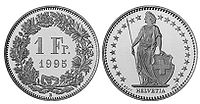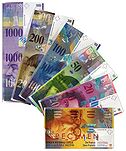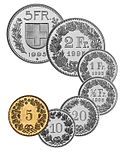
Swiss franc
Did you know...
SOS believes education gives a better chance in life to children in the developing world too. See http://www.soschildren.org/sponsor-a-child to find out about child sponsorship.
| Swiss franc | |||||
|---|---|---|---|---|---|
| Schweizer Franken (German) franc suisse (French) franco svizzero (Italian) franc svizzer (Romansh) |
|||||
|
|||||
| ISO 4217 code | CHF | ||||
| Central bank | Swiss National Bank | ||||
| Website | www.snb.ch | ||||
| Official user(s) | |||||
| Unofficial user(s) | |||||
| Inflation | -0.5% (2009) | ||||
| Source | (de) Statistik Schweiz | ||||
| Subunit | |||||
| 1/100 | Rappen (German) centime (French) centesimo (Italian) rap (Romansh) |
||||
| Symbol | CHF, SFr. (old) | ||||
| Nickname | Stutz, Stei, Eier, Schnägg(5 CHF Coin) ( Swiss German), balle(s) (≥1 CHF) thune (=5 CHF) (French) | ||||
| Plural | Franken (German) francs (French) franchi (Italian) francs (Romansh) |
||||
| Rappen (German) centime (French) centesimo (Italian) rap (Romansh) |
Rappen (German) centimes (French) centesimi (Italian) raps (Romansh) |
||||
| Coins | 5, 10 & 20 centimes, 1/2, 1, 2 & 5 francs | ||||
| Banknotes | 10, 20, 50, 100, 200 & 1000 francs | ||||
| Printer | Orell Füssli Arts Graphiques SA (Zürich) | ||||
| Mint | Swissmint | ||||
| Website | http://www.swissmint.ch/en-homepage.homepage.html | ||||
The franc (German: Franken, French and Romansh: franc, Italian: franco; code: CHF) is the currency and legal tender of Switzerland and Liechtenstein; it is also legal tender in the Italian exclave Campione d'Italia. Although not formally legal tender in the German exclave Büsingen (the sole legal currency is the euro), it is in wide daily use there. The Swiss National Bank issues banknotes and the federal Swissmint issues coins.
The Swiss franc is the only version of the franc still issued in Europe. The smaller denomination, a hundredth of a franc, is a Rappen (Rp.) in German, centime (c.) in French, centesimo (ct.) in Italian, and rap (rp.) in Romansh. The ISO code of the currency used by banks and financial institutions is CHF, although "Fr." is used by most businesses and advertisers; some use SFr.; the Latinate "CHF" stands for Confoederatio Helvetica.
History
Before the Helvetic Republic
Before 1798, about 75 entities were making coins in Switzerland, including the 25 cantons and half-cantons, 16 cities, and abbeys, resulting in about 860 different coins in circulation, with different values, denominations and monetary systems.
See Basel thaler, Berne thaler, Fribourg gulden, Geneva thaler, Geneva genevoise, Luzern gulden, Neuchâtel gulden, St. Gallen thaler, Schwyz gulden, Solothurn thaler, Valais thaler and Zürich thaler.
Franc of the Helvetic Republic, 1798–1803
In 1798, the Helvetic Republic introduced a currency based on the Berne thaler, subdivided into 10 batzen or 100 rappen. The Swiss franc was equal to 6¾ grams pure silver or 1½ French francs.
This franc was issued until the end of the Helvetic Republic in 1803, but served as the model for the currencies of several cantons in the re-formed Swiss Confederacy. For these cantonal currencies, see Aargau frank, Appenzell frank, Basel frank, Berne frank, Fribourg frank, Geneva franc, Glarus frank, Graubünden frank, Luzern frank, St. Gallen frank, Schaffhausen frank, Schwyz frank, Solothurn frank, Thurgau frank, Ticino franco, Unterwalden frank, Uri frank, Vaud franc and Zürich frank.
Franc of the Swiss confederation, 1850–
Although 22 cantons and half-cantons issued coins between 1803 and 1850, less than 15% of the money in circulation in Switzerland in 1850 was locally produced, with the rest being foreign, mainly brought back by mercenaries. In addition, some private banks also started issuing the first banknotes, so that in total, at least 8000 different coins and notes were in circulation at that time, making the monetary system extremely complicated.
In order to solve this problem, the new Swiss Federal Constitution of 1848 specified that the Federal Government would be the only entity allowed to make money in Switzerland. This was followed two years later by the first Federal Coinage Act, passed by the Federal Assembly on 7 May 1850, which introduced the franc as the monetary unit of Switzerland. The franc was introduced at par with the French franc. It replaced the different currencies of the Swiss cantons, some of which had been using a franc (divided into 10 batzen and 100 rappen) which was worth 1½ French francs.
In 1865, France, Belgium, Italy, and Switzerland formed the Latin Monetary Union, wherein they agreed to value their national currencies to a standard of 4.5 grams of silver or 0.290322 grams of gold. Even after the monetary union faded away in the 1920s and officially ended in 1927, the Swiss franc remained on that standard until 1936, when it suffered its sole devaluation, on 27 September during the Great Depression. The currency was devalued by 30% following the devaluations of the British pound, U.S. dollar and French franc. In 1945, Switzerland joined the Bretton Woods system and pegged the franc to the U.S. dollar at a rate of $1 = 4.30521 francs (equivalent to 1 franc = 0.206418 grams of gold). This was changed to $1 = 4.375 francs (1 franc = 0.203125 grams of gold) in 1949.
Between mid-2003 and mid-2006, the franc's exchange rate with the euro had been stable at a value of about 1.55 CHF per euro, so that the Swiss franc has risen and fallen in tandem with the euro against the U.S. dollar and other currencies. In March 2008 the Swiss franc traded above one U.S. dollar for the first time.
The Swiss franc has historically been considered a safe haven currency with virtually zero inflation and a legal requirement that a minimum of 40% be backed by gold reserves. However, this link to gold, which dates from the 1920s, was terminated on 1 May 2000 following a referendum. By March 2005, following a gold selling program, the Swiss National Bank held 1,290 tonnes of gold in reserves which equated to 20% of its assets.
Coins
Coins of the Helvetic Republic
Between 1798 and 1803, billon coins were issued in denominations of 1 rappen, ½ batzen, and 1 batzen. Silver coins were issued for 10, 20 and 40 batzen, with the 40 batzen coin also issued with the denomination given as 4 franken. Gold 16 and 32 franc coins were issued in 1800.
Coins of the Swiss Confederation
In 1850, coins were introduced in denominations of 1, 2, 5, 10, and 20 centimes and ½, 1, 2, and 5 francs, with the 1 and 2 centimes struck in bronze, the 5, 10, and 20 centimes in billon, and the franc denominations in .900 fine silver. Between 1860 and 1863, .800 fine silver was used, before the standard used in France of .835 fineness was adopted for all silver coins except the 5 francs (which remained .900 fineness) in 1875. In 1879, billon was replaced by cupro-nickel in the 5 and 10 centimes and by nickel in the 20 centimes.
Both world wars only had a small effect on the Swiss coinage, with brass and zinc coins temporarily being issued. In 1931, the size of the 5 franc coin was reduced from 25 grams to 15, with the silver content reduced to .835 fineness. The next year, nickel replaced cupro-nickel in the 5 and 10 centimes.
In the late 1960s, due to their linkage to the devaluing U.S. dollar, the prices of internationally traded commodities rose significantly. A silver coin's material value exceeded its monetary value, and many were being sent abroad for melting, which prompted the federal government to make this practice illegal. The statute was of little effect, and the melting of francs only subsided when the collectible value of the remaining francs again exceeded their material value.
The 1 centime coin was still produced until 2006, albeit in ever decreasing quantities, but it did not play any great role in the monetary economy in the fourth quarter of the twentieth century (circa 1975 to 2000). People and groups who could justify the use of 1 centime coins for monetary purposes could obtain them at face value; any other user (such as collectors) had to pay an additional 4 centimes per coin to cover the production costs, which had exceeded the actual face value of the coin for many years. The coin fell into disuse in the late 1970s and early 1980s but was only officially fully withdrawn from circulation and declared to be no longer legal tender as of 1 January 2007. The long-forgotten 2 centime coin, not minted since 1974, was demonetized 1 January 1978.
| 1 Swiss franc 1995 | |
|---|---|
 |
|
| Reverse | Obverse |
The designs of the coins have changed very little since 1879. Among the notable changes were new designs for the 5 franc coins in 1888, 1922, 1924 (minor) and 1931 (mostly just a size reduction). A new design for the bronze coins was used from 1948. Coins depicting a ring of stars (such as the 1 franc coin seen beside this paragraph) were modified from 22 stars to 23 stars in 1983; since the stars represent the Swiss cantons, it was updated to represent the 1979 expansion of the Swiss federation, when Jura seceded from the Canton of Bern and became the 23rd canton.
The 10 centime coins from 1879 onwards (except the years 1918-19 and 1932–39) have had the same composition, size and design until now (2009) and are still legal tender and found in circulation.
All Swiss coins are language-neutral (at least with respect to Switzerland's four national languages), featuring only numerals, the abbreviation "Fr." for franc, and the Latin phrases "Helvetia", "Confœderatio Helvetica" (depending on the denomination) or the inscription " Libertas" (roman goddess of liberty) on the small coins. The name of the artist is present on the coins with the standing Helvetia and the herder.
In addition to these general circulation coins, numerous series of commemorative coins have been issued, as well as silver and gold coins. These coins are no more legal tender, but can be exchanged for face value at post offices, and at national and cantonal banks. Their material or collector's value equals or exceeds their face value.
| Overview of current Swiss coins | |||||
|---|---|---|---|---|---|
| Value | Diameter (mm) |
Thickness (mm) |
Weight (g) |
Composition | Remarks |
| 5 centimes | 17.15 | 1.25 | 1.8 | Aluminium bronze | Made in Cupronickel or pure Nickel until 1980 |
| 10 centimes | 19.15 | 1.45 | 3 | Cupronickel | Made in current minting since 1879 |
| 20 centimes | 21.05 | 1.65 | 4 | Cupronickel | |
| 1/2 franc (50 centimes) |
18.20 | 1.25 | 2.2 | Cupronickel | In silver until 1967 |
| 1 franc | 23.20 | 1.55 | 4.4 | Cupronickel | In silver until 1967 |
| 2 francs | 27.40 | 2.15 | 8.8 | Cupronickel | In silver until 1967 |
| 5 francs | 31.45 | 2.35 | 13.2 | Cupronickel | In silver until 1967 and in 1969 |
Circulation
As of March 2010, the total value of released Swiss coins and banknotes was 49,664.0 million Swiss francs.
| Value of Swiss coins and banknotes in circulation as of March 2010 (in millions of CHF) | ||||||||
|---|---|---|---|---|---|---|---|---|
| Coins | 10 francs | 20 francs | 50 francs | 100 francs | 200 francs | 500 francs | 1000 francs | Total |
| 2695.4 | 656.7 | 1416.7 | 1963.0 | 8337.4 | 6828.0 | 129.9 | 27,637.1 | 49,664.0 |
Combinations of up to 100 usual Swiss coins (not including special or commemorative coins) are legal tender; banknotes are legal tender for any amount.
Reserve currency
The Swiss Franc is used as a reserve currency around the world and is currently ranked rarely 5th or 6th in value held as reserves after the US Dollar, the euro, the Japanese Yen and the pound sterling.
| 1995 | 1996 | 1997 | 1998 | 1999 | 2000 | 2001 | 2002 | 2003 | 2004 | 2005 | 2006 | 2007 | 2008 | 2009 | 2010 | 2011 | Latest data 2012 Q3 |
|
|---|---|---|---|---|---|---|---|---|---|---|---|---|---|---|---|---|---|---|
| US dollar | 59.0% | 62.1% | 65.2% | 69.3% | 71.0% | 70.5% | 70.7% | 66.5% | 65.8% | 66.0% | 66.4% | 65.7% | 64.1% | 64.1% | 62.1% | 61.8% | 62.1% | 61.8% |
| Euro | 17.9% | 18.8% | 19.8% | 24.2% | 25.3% | 24.9% | 24.3% | 25.2% | 26.3% | 26.4% | 27.6% | 26.0% | 24.9% | 24.1% | ||||
| German mark | 15.8% | 14.7% | 14.5% | 13.8% | ||||||||||||||
| French franc | 2.4% | 1.8% | 1.4% | 1.6% | ||||||||||||||
| Pound sterling | 2.1% | 2.7% | 2.6% | 2.7% | 2.9% | 2.8% | 2.7% | 2.9% | 2.6% | 3.2% | 3.6% | 4.2% | 4.7% | 4.0% | 4.3% | 3.9% | 3.8% | 4.1% |
| Japanese yen | 6.8% | 6.7% | 5.8% | 6.2% | 6.4% | 6.3% | 5.2% | 4.5% | 4.1% | 3.8% | 3.7% | 3.2% | 2.9% | 3.1% | 2.9% | 3.7% | 3.6% | 4.1% |
| Swiss franc | 0.3% | 0.2% | 0.4% | 0.3% | 0.2% | 0.3% | 0.3% | 0.4% | 0.2% | 0.2% | 0.1% | 0.2% | 0.2% | 0.1% | 0.1% | 0.1% | 0.3% | 0.3% |
| Other | 13.6% | 11.7% | 10.2% | 6.1% | 1.6% | 1.4% | 1.2% | 1.4% | 1.9% | 1.9% | 1.9% | 1.5% | 1.8% | 2.2% | 3.1% | 4.4% | 5.3% | 5.5% |
| Sources: | ||||||||||||||||||
Current exchange rates
| Current CHF exchange rates | |
|---|---|
| From Google Finance: | AUD CAD EUR GBP HKD JPY USD |
| From Yahoo! Finance: | AUD CAD EUR GBP HKD JPY USD |
| From XE.com: | AUD CAD EUR GBP HKD JPY USD |
| From OANDA.com: | AUD CAD EUR GBP HKD JPY USD |
| From fxtop.com: | AUD CAD EUR GBP HKD JPY USD |




